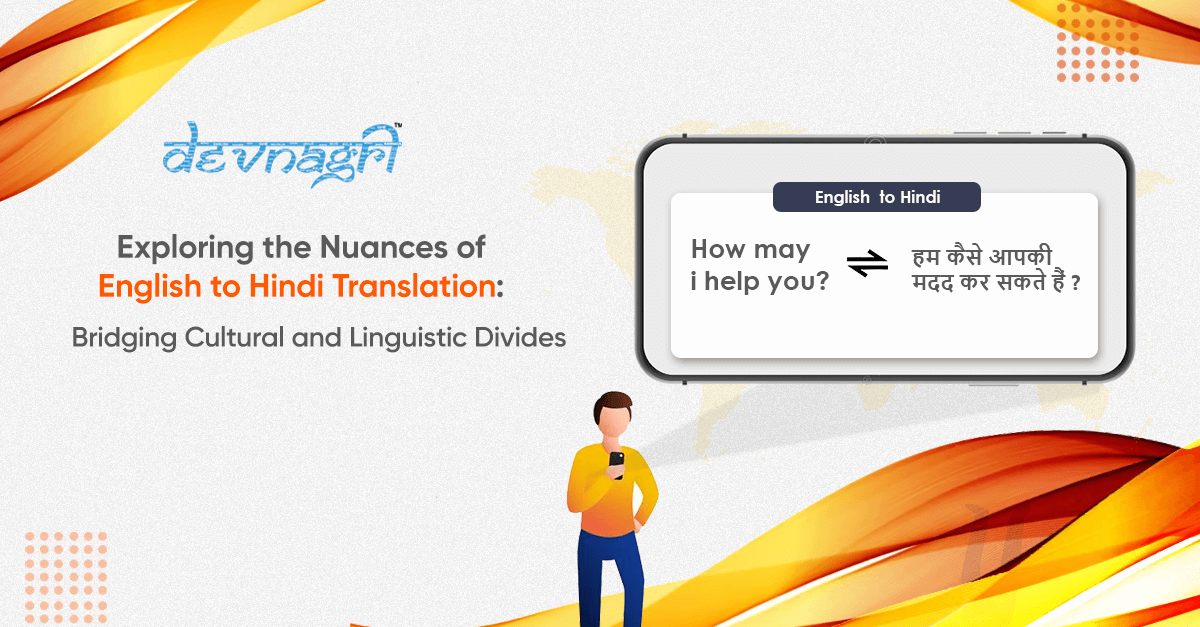
In a world that’s increasingly interconnected, the need for effective communication across languages has become more pronounced than ever before. Among the myriad of language pairs, English to Hindi translation holds a special significance due to the vast number of speakers of both languages and their cultural influence. Translating from English to Hindi isn’t just about converting words; it’s about capturing the essence, nuances, and cultural context inherent in both languages. In this blog post, we delve into the complexities and intricacies involved in English to Hindi translation, highlighting the challenges, techniques, and importance of maintaining fidelity to the original message while ensuring it resonates with the Hindi-speaking audience.
Also Read: Navigating the Complexities of Finance Translation: Bridging Language Gaps for Global Success
Understanding the Linguistic and Cultural Landscape
English and Hindi belong to different language families, with English being a Germanic language and Hindi belonging to the Indo-Aryan family. This fundamental difference in linguistic structure and origin poses several challenges when translating between the two languages. English relies heavily on word order and tense for meaning, while Hindi employs a system of grammatical gender, case marking, and verb agreement.
Moreover, both languages are deeply rooted in distinct cultural contexts, with English often reflecting Western perspectives and Hindi embodying the cultural nuances of the Indian subcontinent. Translating cultural concepts, idiomatic expressions, and colloquialisms requires not only linguistic proficiency but also cultural sensitivity and awareness.
Also Read: Navigating the World of Document Translation Agencies: Your Ultimate Guide
Challenges in English to Hindi Translation
Translating from English to Hindi involves navigating a multitude of challenges, ranging from differences in vocabulary and syntax to cultural nuances and idiomatic expressions. Here are some of the key challenges translators face:
- Idiomatic Expressions: English is replete with idiomatic expressions that may not have direct equivalents in Hindi. Translators must creatively adapt these expressions to convey the intended meaning while maintaining cultural relevance.
- Cultural Specificity: Certain cultural references in English may not resonate with Hindi-speaking audiences. Translators need to find culturally appropriate equivalents or provide explanatory notes to ensure comprehension.
- Grammatical Differences: English and Hindi have distinct grammatical structures, particularly concerning verb conjugation, noun declension, and sentence formation. Translators must navigate these differences to produce grammatically correct and natural-sounding translations.
- Technical and Specialized Terminology: Translating technical, scientific, or specialized content requires a deep understanding of the subject matter and proficiency in both languages to ensure accuracy and clarity.
Also Read: Unlocking Global Markets: The Role of a Website Translation Agency
Techniques for Effective Translation
Overcoming the challenges inherent in English to Hindi translation requires a combination of linguistic expertise, cultural insight, and translation techniques. Here are some strategies employed by translators to achieve effective translations:
- Transliteration vs. Translation: Depending on the context, translators may choose between transliterating certain terms or phrases directly from English to Hindi or translating them to convey the meaning effectively.
- Cultural Adaptation: Adapting cultural references, idiomatic expressions, and metaphors to resonate with Hindi-speaking audiences without compromising the original intent of the text.
- Maintaining Tone and Style: Preserving the tone, style, and register of the original text while ensuring readability and coherence in the target language.
- Contextual Understanding: Developing a deep understanding of the context, audience, and purpose of the translation to convey the message accurately and effectively
Also Read: Transforming Visuals into Words: The Power of Image to Text Converter Online
Importance of Accurate Translation
The significance of accurate translation from English to Hindi cannot be overstated, especially in today’s globalized world where communication transcends linguistic barriers. Whether it’s for business, education, entertainment, or diplomacy, accurate translation plays a pivotal role in fostering understanding, fostering cultural exchange, and bridging divides.
In a multicultural and multilingual society like India, where Hindi serves as a lingua franca among speakers of various regional languages, quality translation enables access to information, knowledge, and opportunities for millions of people. From literature and media to legal documents and technical manuals, the impact of accurate translation reverberates across diverse domains, enriching lives and facilitating collaboration across linguistic and cultural boundaries.
Also Read: Enhancing Communication Across Boundaries: The Power of Translation APIs
Conclusion
English to Hindi translation is both an art and a science, requiring translators to navigate linguistic, cultural, and contextual complexities with finesse and precision. As the world becomes increasingly interconnected, the demand for skilled translators proficient in English and Hindi continues to grow.
By embracing the challenges, employing effective translation techniques, and prioritizing accuracy and cultural sensitivity, translators can bridge linguistic divides, foster cross-cultural understanding, and facilitate meaningful communication between English and Hindi speakers. In doing so, they contribute to the enrichment and empowerment of individuals and communities, transcending borders and fostering a more inclusive and interconnected world.





